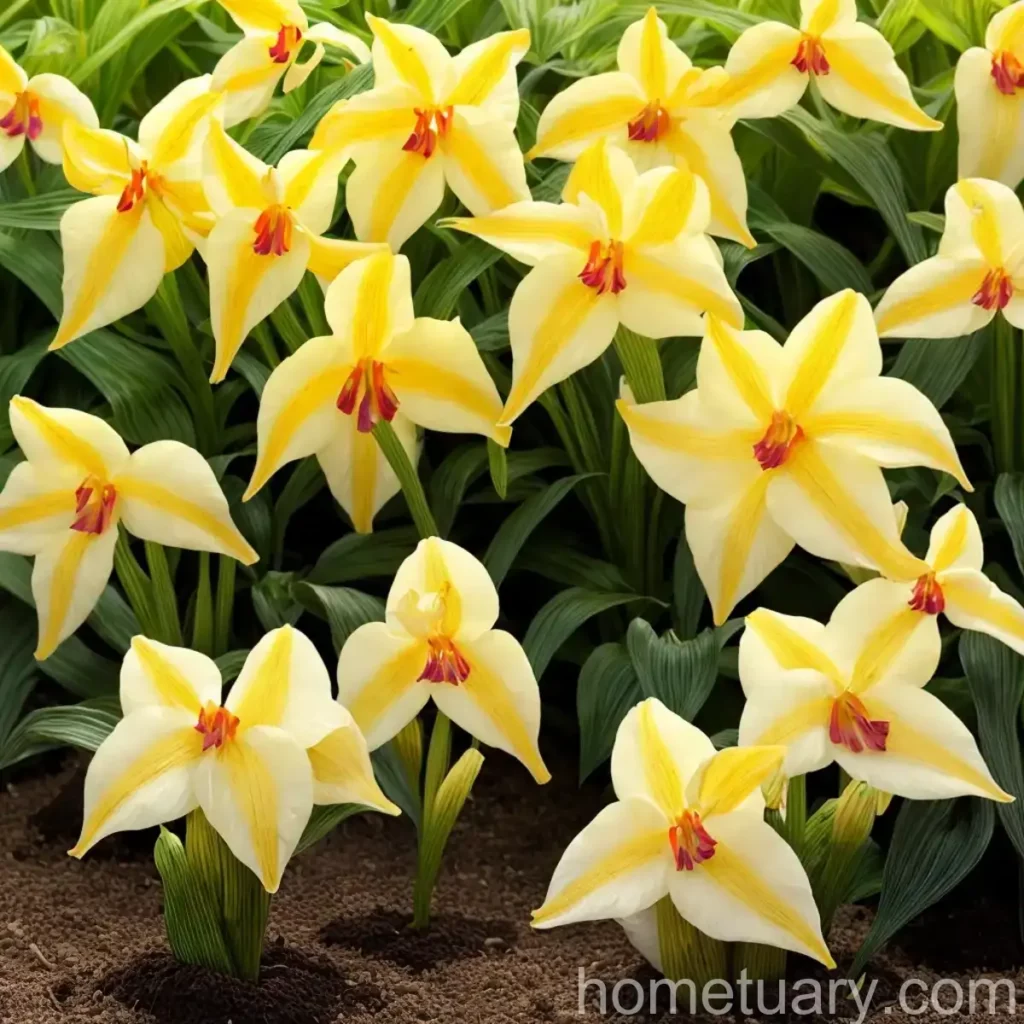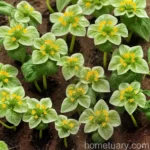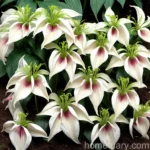Golden Arrowhead Plant (Syngonium Podophyllum ‘Golden Illusion’)
The Golden Arrowhead Plant, also known as Syngonium Podophyllum ‘Golden Illusion’, is a striking and popular houseplant known for its attractive foliage and ease of care. This plant belongs to the Araceae family and is native to Latin America. With its arrowhead-shaped leaves and golden-yellow variegation, it adds a touch of elegance to any indoor space.
In this comprehensive guide, we will delve into the key aspects of cultivating and caring for the Golden Arrowhead Plant. From its preferred growing conditions to propagation methods and common issues, we will explore every facet of nurturing this stunning plant.
What is a Plant: Golden Arrowhead Plant (Syngonium Podophyllum ‘Golden Illusion’)?
Description
The Golden Arrowhead Plant, scientifically known as Syngonium Podophyllum ‘Golden Illusion’, is a tropical evergreen vine that is widely cultivated as an ornamental houseplant. It is characterized by its distinct arrow-shaped leaves, typically displaying variegation in different shades of green and yellow. This plant is valued for its lush foliage and is often used to add a touch of greenery to indoor environments.
Origin
Syngonium Podophyllum, the species to which the Golden Arrowhead Plant belongs, is native to Latin America, particularly Mexico and Central America. It thrives in the warm and humid conditions of tropical rainforests, where it can be found climbing trees or growing along the forest floor.
Common Names
The Golden Arrowhead Plant is also commonly referred to as the Syngonium ‘Golden Illusion’ or simply the Syngonium Golden Arrowhead.
Classification
The Golden Arrowhead Plant falls within the Araceae family, which encompasses a wide array of flowering plants commonly known as aroids. This family includes many popular ornamental plants such as Philodendrons, Monsteras, and Anthuriums.
Key Takeaways – Golden Arrowhead Plant (Syngonium Podophyllum ‘Golden Illusion’)
The following are the key takeaways from this detailed guide on the Golden Arrowhead Plant:
- The Golden Arrowhead Plant, or Syngonium Podophyllum ‘Golden Illusion’, is a tropical evergreen vine prized for its striking foliage and ease of care.
- This plant features arrow-shaped leaves with attractive yellow variegation, making it a popular choice for indoor display.
- Cultivating a Golden Arrowhead Plant involves providing it with the right balance of water, sunlight, and nutrients.
- Propagation of the Syngonium Podophyllum ‘Golden Illusion’ can be achieved through various methods, such as stem cuttings and division.
- While generally low-maintenance, the Golden Arrowhead Plant may be susceptible to certain pests and diseases, requiring proactive management.
Now, let’s explore the various aspects of caring for this exquisite plant in more detail.
Culture
Cultivating the Golden Arrowhead Plant involves creating an environment that mimics its natural habitat, providing the right balance of warmth, moisture, and light. Understanding the plant’s preferred cultural conditions is crucial for its overall health and vitality.
Uses
The Syngonium Podophyllum ‘Golden Illusion’ is primarily grown as an ornamental houseplant, adorning interiors with its vibrant foliage. It is a popular choice for indoor decoration, adding a touch of tropical allure to homes, offices, and other indoor spaces.
Water
Golden Arrowhead Plant Water Needs
One of the fundamental aspects of caring for the Golden Arrowhead Plant is managing its water requirements. Being a tropical plant, it thrives in a moist environment but is susceptible to issues related to overwatering. Here are some key considerations for watering the plant:
-
Consistent Moisture: The Golden Arrowhead Plant prefers consistently moist soil, but it’s important to avoid waterlogging, as this can lead to root rot. Ensure the soil does not dry out completely between waterings, but also avoid letting the plant sit in water for prolonged periods.
-
Watering Frequency: The frequency of watering will depend on various factors such as the ambient humidity, the size of the plant, and the type of pot and soil used. As a general guideline, water the plant when the top inch of the soil feels dry to the touch.
-
Water Quality: It is beneficial to use room-temperature water to avoid shocking the plant with cold water. Additionally, using filtered or distilled water can help prevent the buildup of salts and minerals in the soil, which may affect the plant’s health.
Sunlight
Golden Arrowhead Plant Light Requirements
Proper sunlight is essential for the Golden Arrowhead Plant to thrive and maintain its vibrant foliage. Understanding the plant’s light preferences is crucial for achieving optimal growth and coloration. Here’s what you need to know about providing the right amount of light for the Syngonium Podophyllum ‘Golden Illusion’:
-
Indirect Light: The Golden Arrowhead Plant thrives in bright, indirect light. Exposure to direct sunlight, especially during the hot afternoon hours, can scorch its delicate leaves. Therefore, it is best to place the plant in a location where it can receive ample but filtered sunlight.
-
Low-Light Tolerance: While the plant prefers bright conditions, it can tolerate lower light levels, making it suitable for indoor environments with limited natural light. However, to maintain its variegation and promote healthy growth, it is advisable to provide adequate brightness.
-
Avoiding Direct Sun Exposure: Direct sun exposure can lead to leaf burn, manifesting as brown spots or patches on the foliage. To protect the plant from such damage, consider placing it near east or west-facing windows where it can benefit from indirect sunlight.
Fertilizer
Golden Arrowhead Plant Fertilizer Needs
Proper fertilization is essential for maintaining the health and vigor of the Golden Arrowhead Plant. Providing the plant with essential nutrients supports balanced growth and vibrant foliage. Here are some recommendations for fertilizing the Syngonium Podophyllum ‘Golden Illusion’:
-
Balanced Fertilizer: Choose a balanced, water-soluble fertilizer with a formulation such as 20-20-20 or 15-15-15 for regular feeding. This ensures that the plant receives a well-rounded combination of nitrogen, phosphorus, and potassium, along with trace elements.
-
Application Frequency: During the growing season, from spring through summer, feed the Golden Arrowhead Plant every 4-6 weeks. Reduce or cease fertilization during the plant’s dormancy period in fall and winter, when its growth naturally slows down.
-
Dilution and Application: Dilute the fertilizer to half or a quarter of the recommended strength to avoid overfeeding, which can lead to salt buildup in the soil. Apply the diluted fertilizer to the plant’s moist soil, ensuring it is evenly distributed around the root zone.
Soil
Golden Arrowhead Plant Soil Requirements
Selecting the right type of soil is crucial for the Golden Arrowhead Plant to thrive and remain healthy. The soil should provide adequate aeration, drainage, and support for the plant’s root system. Consider the following factors when choosing or preparing soil for the Syngonium Podophyllum ‘Golden Illusion’:
-
Well-Draining Mix: Use a well-draining potting mix that allows excess water to flow through easily, preventing waterlogging. A mix formulated for aroid plants, such as Philodendrons and Anthuriums, is suitable for the Golden Arrowhead Plant.
-
Organic Matter: Incorporate organic matter such as peat moss or perlite into the soil mix to enhance its moisture retention and nutrient-holding capacity. Organic amendments promote a healthy soil structure and microbial activity, benefiting the plant’s root development.
-
Acidic to Neutral pH: The soil pH should ideally range from slightly acidic to neutral, around 5.5 to 6.5, to support nutrient uptake and prevent nutrient deficiencies. Regular monitoring of the soil pH can help ensure the plant’s nutritional needs are met.
Pruning
Golden Arrowhead Plant Pruning Techniques
Pruning is an important aspect of maintaining the Golden Arrowhead Plant’s shape, controlling its size, and promoting bushier growth. Proper pruning can also help manage any leggy or unsightly growth, ensuring the plant remains visually appealing. Here are some key considerations for pruning the Syngonium Podophyllum ‘Golden Illusion’:
-
Regular Maintenance: Periodic pruning can help remove any dead or yellowing leaves, keeping the plant aesthetically pleasing. Use clean, sharp scissors or pruning shears to make precise cuts without causing unnecessary damage to the foliage.
-
Encouraging Bushiness: To encourage a fuller, bushier appearance, consider pinching off the growing tips of the plant’s stems. This promotes lateral branching, resulting in a denser and more compact growth habit.
-
Removing Unwanted Growth: Cut back any leggy or overextended stems to maintain a balanced and symmetrical appearance. Additionally, remove any damaged or diseased foliage to protect the overall health of the plant.
Propagation
Propagating the Golden Arrowhead Plant allows enthusiasts to expand their plant collection and share the beauty of this tropical vine with others. The Syngonium Podophyllum ‘Golden Illusion’ can be propagated through several methods, each with its own benefits and considerations.
Stem Cuttings
Golden Arrowhead Plant Propagation through Stem Cuttings
Propagating the Golden Arrowhead Plant through stem cuttings is a popular and reliable method that enables growers to create new plants from established ones. Here’s a step-by-step guide to propagating the Syngonium Podophyllum ‘Golden Illusion’ using stem cuttings:
-
Selecting the Cutting: Choose a healthy stem with several sets of leaves. Using clean, sharp shears, make a cutting just below a node, which is the point where a leaf meets the stem.
-
Preparation: Remove the lower leaves from the cutting to expose the nodes, which will be the points from which new roots will develop. It is optimal to have at least one or two nodes on the cutting for successful propagation.
-
Rooting Medium: Place the cut end of the stem cutting in a suitable rooting medium, such as a mix of perlite and peat, or a specialized propagation mix. Ensure the medium is moist but not waterlogged, and provide the cutting with the right balance of warmth and humidity.
-
Root Development: Over the next few weeks, the cutting should develop roots from the nodes. Keep the rooting medium consistently moist and provide indirect light to support the rooting process.
-
Transplanting: Once the cutting has developed a healthy root system, it can be transplanted into a small pot with well-draining soil. Continue to care for the young plant as it establishes itself in its new environment.
Division
Golden Arrowhead Plant Propagation through Division
Another method for propagating the Syngonium Podophyllum ‘Golden Illusion’ is through division, which involves separating the plant into smaller sections, each with its own root system. This approach can help rejuvenate established plants and create new individuals.
-
Preparation: Carefully remove the plant from its pot and gently shake off excess soil to expose the root system. Identify natural points of division where the plant can be separated into smaller sections.
-
Cutting and Replanting: Use clean, sharp tools to divide the plant into sections, ensuring that each section has a good portion of roots and several stems or growing points. Replant the divided sections in suitable pots with fresh potting mix.
-
Aftercare: Keep the newly divided plants in a warm, humid environment with indirect light to support their transition and encourage root establishment. Maintain consistent moisture in the soil to aid in the plants’ recovery.
Air Layering
Golden Arrowhead Plant Propagation through Air Layering
Air layering is an alternative propagation technique that can be effective for the Golden Arrowhead Plant, particularly when dealing with older or larger specimens. This method allows for the development of roots on a section of a stem while it is still attached to the parent plant.
-
Selecting the Stem Section: Identify a healthy, mature stem on the plant and choose a section where air layering will be performed. Make an upward diagonal cut into the stem, being careful not to sever the stem completely.
-
Preparation and Enclosure: Place a small amount of rooting hormone or moist sphagnum moss at the cut site to encourage root development. Wrap the cut section with plastic wrap or foil to create a moist, enclosed environment that promotes root growth.
-
Root Formation: Over time, typically several weeks to a few months, the enclosed section of the stem should develop a system of roots. Once a sufficient root mass has formed, the rooted section can be carefully separated from the parent plant and potted up as a new individual.
Container Popularity
The Golden Arrowhead Plant is a favored choice for container gardening, particularly for individuals seeking to bring a touch of nature into their indoor spaces. Its compact growth habit and striking foliage make it well-suited for various types of containers, from traditional plant pots to hanging baskets and creative, decorative displays.
Common Diseases
Caring for the Golden Arrowhead Plant also involves being mindful of potential diseases that can affect its health and appearance. While the plant is relatively resilient, certain issues may arise, requiring prompt diagnosis and intervention.
Disease Diagnosis
Recognizing the symptoms of common plant diseases can help plant enthusiasts take proactive steps to manage and prevent the spread of infections. Some potential diseases that may affect the Golden Arrowhead Plant include:
-
Leaf Spot: Characterized by the appearance of dark, water-soaked spots or patches on the plant’s leaves, leaf spot may be caused by fungal or bacterial pathogens. Proper plant hygiene and avoiding overhead watering can help prevent this issue.
-
Root Rot: Overwatering or poorly drained soil can lead to root rot, a condition where the plant’s roots decay due to excessive moisture. Yellowing and wilting of the foliage, along with a foul odor from the soil, may indicate root rot.
-
Powdery Mildew: A white, powdery fungal growth on the plant’s leaves may indicate the presence of powdery mildew. Maintaining good air circulation and avoiding overcrowding of plants can help prevent this common fungal disease.
-
Bacterial Blight: Bacterial blight can cause brown, water-soaked areas on the plant’s leaves and stems, often leading to wilting and dieback. Sanitation and proper watering practices are essential for preventing bacterial blight.
Common Pests
In addition to diseases, the Golden Arrowhead Plant may be susceptible to infestations by various pests. Vigilance and proactive pest management are crucial for protecting the plant from potential damage caused by unwanted visitors.
Botanist’s Tips
As a plant scientist, here are some expert tips for caring for the Golden Arrowhead Plant (Syngonium Podophyllum ‘Golden Illusion’):
-
Consistent Moisture: Maintaining consistent moisture levels in the soil without allowing water stagnation is key to supporting the plant’s growth and preventing issues such as root rot.
-
Avoid Direct Sun: Protect the plant from direct sun exposure, particularly during the intense midday hours, as this can cause leaf burn and diminish the plant’s overall health.
-
Regular Pruning: Engage in regular maintenance pruning to remove any damaged or unsightly foliage, promoting a tidy and vibrant appearance for the plant.
-
Monitor Plant Health: Keep a close eye on the plant’s foliage for any signs of pests, diseases, or stress, and take appropriate action to address any issues promptly.
Fun Facts
-
The Golden Arrowhead Plant is often admired for its air-purifying capabilities, helping to improve indoor air quality by filtering out pollutants and enhancing oxygen levels.
-
The plant may exhibit different leaf shapes and variegation patterns as it matures, adding an element of intrigue to its visual appeal.
-
The Golden Arrowhead Plant is believed to bring good luck and prosperity, making it a popular choice for gift-giving and housewarming presents.
Links to External Resources
For further information and resources on the Golden Arrowhead Plant, consider exploring the following links:
- Royal Horticultural Society – Syngonium Podophyllum
- University of Florida IFAS Extension – Arrowhead Plant
- Missouri Botanical Garden – Syngonium Podophyllum
- Houseplant Central – Syngonium Podophyllum Care Guide
- American Society for the Prevention of Cruelty to Animals – Toxic and Non-Toxic Plants: Arrowhead Vine
In essence, the Golden Arrowhead Plant (Syngonium Podophyllum ‘Golden Illusion’) is a versatile and attractive addition to any indoor plant collection. Its vibrant foliage, ease of care, and air-purifying qualities make it a sought-after choice for plant enthusiasts of all levels. By understanding and implementing the proper cultural practices, propagation methods, and pest and disease management strategies, individuals can enjoy the beauty and benefits of this tropical vine in their homes and indoor environments.
Remember to always refer to specific care instructions for your plant, and use this guide as a general reference to nurturing the Golden Arrowhead Plant. Happy gardening and may your Syngonium Podophyllum ‘Golden Illusion’ thrive and bring joy to your living spaces!















